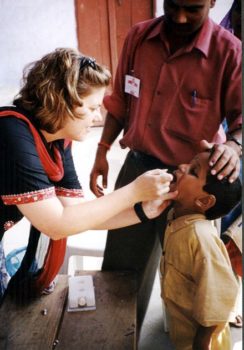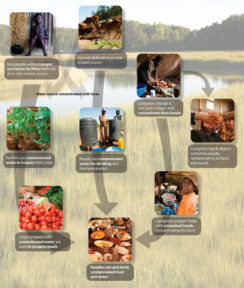Childhood Malnutrition in India
Part 1: The Science of Nutrition and Malnutrition.
Today’s post is number three in the run-up to my International Reporting Project trip to India where I will be part of a team of 10 journalists covering the topic of child survival. First, I addressed Infectious Diseases, then Vaccinations. Today, we will look at Malnutrition. What is the state of malnutrition in India? How has scientific understanding of what good nourishment means helped us work on the malnourishment issue particularly in developing nations? Can science put an end to world hunger? How are sanitation and hygiene related to malnutrition?
Before we go on, let’s define a few terms so there is no confusion:
- Malnutrition is the condition that occurs when your body does not get enough nutrients.
- Starvation is a severe deficiency in caloric energy, nutrient, and vitamin intake.
- Famine is a widespread scarcity of food, usually accompanied or followed by regional malnutrition, starvation, epidemic, and increased mortality.
- Emaciation is abnormal thinness caused by lack of nutrition or by disease.
- Marasmus is chronic wasting of body tissues, especially in young children, commonly due to prolonged dietary deficiency of protein and calories.
- Kwashiorkor is a syndrome occurring in infants and young children soon after weaning. It is due to severe protein deficiency, and the symptoms include edema, pigmentation changes of skin and hair, impaired growth and development, distention of the abdomen, and pathologic liver changes.












Can Science and Engineering Change Sanitation in India?
This was originally published at Scientific American
Just a few weeks ago, I flew into India to join other new media specialists and journalists with the International Reporting Project to examine issues of child survival and health. (Before I continue, I simply must extend thanks to the Bill and Melinda Gates Foundation for providing a portion of the IRP funding to make this trip possible, the School of Integrative Biology at UIUC for supporting my participation in the project and GoPro Cameras for outfitting me with a Hero3 for documentation purposes.)
I have talked to many many people who have experienced India, I’ve read numerous books (fiction and non-fiction), and watched many documentaries, TV shows, and fictional movies about India, but knew that the experience of visiting would be something valuable. I was warned of the approximately “five people per square foot” population density in Mumbai, of the smell–a persistent sewer/trash odor, the pollution, the noise, the dogs, cattle, and goats, and the widespread extreme poverty. I discovered that the southern port city of India in Maharashtra State where we first landed, formerly known as Bombay, to be all that and even more. It was humid and warm during our visit, but actually in a relatively cool and dry streak, at least for India. The city, as I was exaggeratively informed by John Schidlovsky, founder and director of the IRP, “was built on mold” and with my allergy to mold so severe that I carry an epipen, I found myself taking more than the recommended dose of allergy meds just to breathe, each day grateful it wasn’t the rainy season. Thankfully, we eventually traveled north to cooler, drier, and less moldy climes to a rural area outside Nagpur and later to New Delhi.
Throughout most of India, I found myself delighted at the fact that women still wear colorful sarees on a daily basis, not yet succumbing to western trends, and impressed that men and boys generally wear button-down shirts, slacks, and nice shoes everyday, no matter their income level or age (try convincing a young boy to do that in America day to day–no way!)
If you have seen the movie “Slumdog Millionaire”, it begins in Mumbai, in one of the largest slums located near the airport and situated right at the largest dumping ground in India. This area was our first stop in order to visit the Niramaya project drop-in health center. We toured the slums and received an overview of healthcare and educational awareness work Niramaya does in the community.
13 years ago Blog, Health, STEM, Travel • Tags: CDC, environmental enteropathy, India, International Reporting Project, Mumbai, open defecation, Rose George, sanitation, Scott Huler, slums, United Nations Children's Fund, WHO